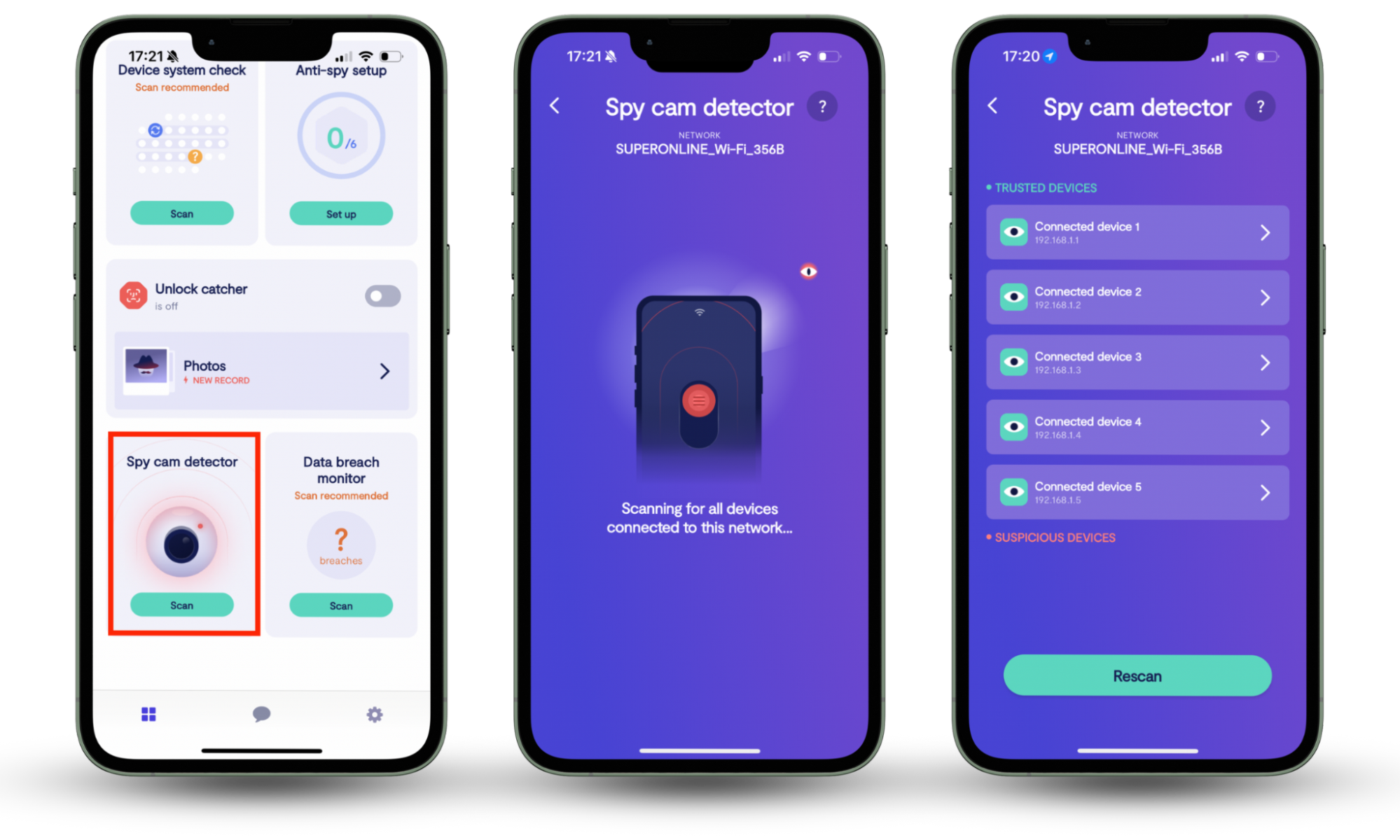Table of contents
- What do car trackers look like
- 1. Hardwire trackers
- 2. Plug-in GPS trackers
- 3. Magnetic trackers
- How to find trackers on your car with your phone
- 1. Exterior inspection
- 2. Interior inspection
- 3. Use bug detector or EMF scanner apps
- 4. Seek professional help
- What to do if you find trackers on your car
- 1. Confirm what kind of device it is
- 2. Remove trackers depending on their type
- Conclusion
What do car trackers look like
To recognize a car tracker, you need to learn what it looks like. Here are the most common types of car trackers that vary by functionality:
- The hardwired tracker is quite compact and often connected to the vehicle's electrical wiring (e.g., underneath the dashboard).
- A plug-in GPS tracker is a rectangular device connected to a car's OBD-II port under the steering wheel.
- A magnetic tracker (also called a portable tracker) is a square or rectangular device powered by batteries that is often attached underneath the car.
Let’s compare them by size, power source, and removal difficulty.
| Tracker type | Size | Power source | Removal difficulty |
| Hardwired trackers | Medium-sized. | Vehicle's electrical system. | High: requires technical expertise and may involve disassembling the vehicle. |
| Plug-in GPS trackers | Compact. | Vehicle's OBD-II port. | Moderate: removable by unplugging. |
| Magnetic trackers | Small and discreet. | Battery-powered, rechargeable. | Low: easily detachable due to magnetic placement. |
1. Hardwire trackers
Hardwired trackers power the car's electrical system, making them perfect for real-time tracking. They are usually attached beneath the dashboard, near the fuse box, or behind interior panels.
Once you've found one, don't hurry to disconnect it. Hardwire trackers are physically connected to the car's wiring. You may need technical expertise or resort to a professional to help you remove it.
2. Plug-in GPS trackers
Typically, plug-in GPS trackers are inserted into the OBD-II (onboard diagnostics) port. An OBD-II port serves as an access point for mechanics and car owners to important data on the vehicle's location, performance, etc.
The port is located under the steering wheel or near the driver's seat. If you find a GPS tracker there, you can easily remove it yourself by unplugging it.
3. Magnetic trackers
These types of trackers rely on a built-in battery. That is why they are easy to attach externally, like underneath the car, wheel wells, and bumpers. Their magnetic casings also allow for attachment to the area around the gas tanks since those are made from metal.
Magnetic trackers' portability and ease of attachment make them ideal for covert tracking. However, since they are not physically connected to the car, it is quite simple to remove them.
Hidden trackers are just one of many concerns for individuals. Oftentimes, spies and stalkers use more intricate devices to invade your privacy, like Wi-Fi cameras. These tiny devices can lead to a serious violation of your private life.
With their help, spies can take illegal videos or photos of you, spy on your daily life, and even use this data to blackmail you.
Sounds scary, right? But don't panic, you can easily locate hidden Wi-Fi cameras with Clario Anti Spy. Our Spy cam detector checks all devices connected to your Wi-Fi and alerts you to disguised cameras or trackers.
Here's how to use Clario Anti Spy's Spy cam detector:
- Download Clario Anti Spy on your mobile device.
- Open the app and go to Spy cam detector.
- Tap Scan and wait for results.

How to find trackers on your car with your phone
You need to take several crucial steps to find and scan your car for a tracking device with your phone:
Let's dive into each step thoroughly.
1. Exterior inspection
Some bugs (magnetic GPS trackers) may be hidden outside your car. Here's how and where to look for them:
- Under wheel wells: Grab a flashlight and a mirror and inspect the inner lining of all four wheel wells, feeling around for small devices.
- Bumpers and the hood: Use a flashlight to check inside the hollow spaces of the front and rear bumpers. Open the hood and inspect the battery area or any unfamiliar wires. Ensure any wires match your car manual's standard setup.
- Undercarriage: Lie on a mat or use a mechanic's creeper to check beneath the car. Pay close attention to the frame, axles, and other metal components where a tracker could be magnetically secured. Look for small, rectangular, or square-shaped devices roughly the size of a fist.
An exterior inspection is important, especially if you have a jealous ex-partner who may not have been happy with the breakup. In January 2025, a case involving a Cube tracker happened in Florida when a 22-year-old Chipotle worker installed it on his former girlfriend's car right in front of her home. All in an attempt to "run into" her again. Fortunately, the woman found the tracking device, and police soon arrested the stalker.
2. Interior inspection
If you didn't find a tracker on the outside of your vehicle, chances are it is hidden somewhere inside. Here's how and where to look for them:
- Under seats and floor mats: You may need to remove the floor mats. Using a flashlight, inspect the area under all seats. Look for tiny gadgets or devices taped or attached to the seat frames or carpeting.
- Glove compartments and other storage areas: Thoroughly inspect the glove compartment to ensure no unfamiliar devices are concealed within. Also, inspect the storage compartments, cupholder areas, and the armrest holster.
- The OBD II port: Inspect your OBD-II port under the steering wheel. If you notice unfamiliar devices plugged into the port, disconnect them immediately.
- Trunk: Remove all your items, including the spare tire, from the trunk. Inspect crevices, the spare tire well, and the surrounding areas for hidden devices.
Tip
Use Clario’s Anti Spy for a more exhaustive interior inspection. Our Spy cam detector feature scans all devices connected to your Wi-Fi and alerts you to any concealed cameras.
3. Use bug detector or EMF scanner apps
Once you've checked your vehicle thoroughly but haven't found a bug, it's time to use technology. You can use physical devices or mobile apps to scan your car for a tracking device with your phone. These devices work by detecting transmission signals.
Here are the tools you can use:
- AirTag detectors: If you keep getting alerts from Apple AirTag, it may be your spouse’s AirTag stalking you to ensure your safety. If it's not your loved one’s, it may be a red flag for your security. You can use the Find My app on iPhone or set up unknown tracker alerts on Android.
- Bluetooth scanners: Apps like LightBlue, BLE Scanner, or Bluetooth Scanner work by checking your surroundings for Bluetooth devices. These are particularly convenient as they help detect connected, paired, or unknown devices using just your phone. Just move it around your car, being meticulous around hard-to-reach places.
- EMF (electromagnetic field) scanners: EMF detectors can quickly locate devices that actively transmit your location. You can buy such a device online or in a specialized tech shop. Alternatively, you can use a mobile app, Electrosmart, to spot active trackers emitting frequencies.
Don’t know whether you should simply download an app or buy a hardware bug detector? Let’s go through the pros and cons of each to help you make the choice.
Pros and cons of bug detector apps
| Easy to access: Simply download it on a smartphone. | Limited capability: Most smartphone built-in sensors are not able to detect low-power devices. |
| Cost-effective: Some apps are free. | False alarms: Sometimes, apps misinterpret electronic devices or magnetic fields. |
| Infrared detection: Some apps can spot IR light emitted by hidden cameras. | Law reliability: App bug detectors may not be enough for high-level security scenarios (e.g., if a disruption of privacy can lead to reputational damage or financial losses). |
Pros and cons of hardware bug detectors
| Great precision: can identify a wide range of signals and frequencies with higher sensitivity. | High cost: high-end hardware detectors can be expensive (some models might range from $800 to $3000). |
| Superior detection: can locate well-shielded or low-power bugs. | Bulky: standalone devices that users have to carry and operate separately. |
| Reliable: ideal for high-level security scenarios. | Require tech expertise: set up and usability may take time to learn. |
4. Seek professional help
Some bugs, especially those hardwired into your car, are extremely tough to find. So if your searches didn't yield results, it may be time to resort to professionals. Ask your trusted mechanic to inspect your car.
If no bugs were found but you still suspect surveillance, consult private investigators or hire them to do the sweep. If they manage to find a bug, it may be one of the signs that someone is stalking you.
What to do if you find trackers on your car
Found a tracker on your car? This can be stressful, but immediate action is crucial. Here's what you need to do:
- Confirm what kind of device it is and if it's lawful
- Remove the tracker safely, depending on its type
1. Confirm what kind of device it is
If you find a bug in your car, don't be in a hurry to remove it. While it is possible that your wife can track your car, the bug might be there for other reasons. For instance, law enforcement might use it in an ongoing investigation. If this is the case and you tamper with or remove it, you risk facing charges for obstruction of justice.
Sometimes, trackers are attached by companies that own the vehicles, so it might as well be your employer who attached them. For example, GPS trackers are often used for fleet management, monitoring vehicles' health and performance. If you tamper with or remove those, you risk legal or safety implications. Most trackers have labels and serial numbers, so look for those if you think it may be your company's.
Tip
If you're confident the tracker is unauthorized and violating your personal privacy, go straight to the local police. If law enforcement confirms its illegality, you will be instructed on further steps. Perhaps you may even need to report stalking and consult with your lawyer.
2. Remove trackers depending on their type
Once you're sure disconnecting the tracker is safe and lawful, you can do it yourself or ask the mechanic. This step depends on the bug you find. You may also need to save them as evidence if law enforcement involvement may be required.
To remove a magnetic tracker, simply unfasten its magnetic hold with a firm pull. To remove an OBD tracker, unplug it carefully to avoid damaging the port.
Hardwired trackers are more complicated to remove, as removing them often requires a technical background. Consider hiring a professional mechanic or auto electrician to safely disconnect the tracker and avoid tampering with it yourself.
Are you unsure whether to remove the tracking device or call the police? Here’s a step-by-step safety guide on how you can act in such a case:
- Take care of your safety and make sure there's no immediate threat.
- If you have a suspect, maintain a safe distance from them.
- Determine if you have the necessary knowledge and tools to remove the tracker.
- If you don't feel safe, contact the police immediately.
- Consider consulting a trusted mechanic if you lack the necessary tools or knowledge.
Conclusion
If you suspect your car is being monitored or tracked, it is necessary to sweep your vehicle thoroughly for bugs. They can be hidden both outside and inside, collecting and transmitting data about your location as you move.
However, to remove trackers, you must first locate them, which is often a hard job. You can do the exterior and interior search, and use Bluetooth scanners, EMF device detectors, or AirTag scanners on your phone.
To search for hidden Wi-Fi cameras, use Clario Anti Spy's Spy cam detector. It will help you ensure that no unauthorized devices are invading your privacy.


